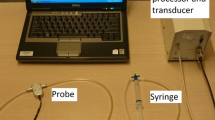Summary
The elastance of a biological tube describes the resistance of the latter to dilatation. It is defined as dP/dV, where dP is the pressure increase caused by the volume increase dV. Elastance is the reciprocal of compliance. Elastance in the female urethra can be estimated from the slope of the regression line of related values of pressure and cross-sectional area. In the present study, urethral elastance was calculated by measurement of the related pressures and cross-sectional areas during stepwise dilatation by a balloon and by determination of the pressure at which inflow through side holes in catheters with increasing diameters began. There was no difference between the elastance values obtained by the two methods. Due to the linear correlation found between pressure and cross-sectional area we conclude that urethral elastance can be estimated from measurements of urethral pressure at two or more related cross-sectional areas by a simple technique using e.g., 8F, 14F, and 20F catheters.
Similar content being viewed by others
References
Brown M, Wickham JEA (1969) The urethral pressure profile. Br J Urol 41:211
Colstrup H (1984) Rigidity of the resting female urethra: I. Static measurements. J Urol 132:78
Colstrup H, Mortensen SO, Kristensen JK (1983) A new method for the investigation of the closure function of the resting female urethra. J Urol 130:507
Colstrup H, Mortensen SO, Kristensen JK (1983) A probe for measurements of related values of cross-sectional area and pressure in the resting female urethra. Urol Res 11:139
Gleason DM, Bottaccini MR, Reilly RJ, Byrne JC (1973) Urethral compliance and its role in female voiding dysfunctions. Invest Urol 11:83
Harada T, Kumazki T, Kigure T, Etori K, Tsuchida S (1989) Effect of adrenergic agents on urethral pressure and urethral compliance measurements in dog proximal urethra. J Urol 142:189
Lose G (1989) Mechanical properties of the urethra in healthy female volunteers: static measurements in the resting urethra. Neurourol Urodyn 8:451
Lose G (1989) Mechanical properties of the urethra in females with genuine stress incontinence: static measurements in the resting urethra. Neurourol Urodyn 8:461
Lose G, Schroeder T (1990) Pressure/cross-sectional area probe in the assessment of urethral closure function. Reproducibility of measurement. Urol Res 18:143
Lose G, Colstrup H, Saksager K, Kristensen JK (1986) New probe for measurement of related values of cross-sectional area and pressure in a biological tube. Med Biol Eng Comput 24:488
Lose G, Colstrup H, Saksager K, Kristensen JK (1988) New method for static and dynamic measurement of related values of cross-sectional area and pressure in the female urethra. Neurourol Urodyn 6:465
Moolgraoker AS, Ardran CM, Smith JC, Stallwarthy JA (1972) The diagnosis and management of urinary incontinence in the female. J Obstet Gynaecol Br Commonw 79:481
Regnier CH (1986) Direct static measurement of obstruction. Neurourol Urodyn 5:251
Susset JG, Ghoniem GM, Regnier CH (1983) Abnormal urethral compliance in females. Diagnosis, results and treatment. J Urol 129:1063
Author information
Authors and Affiliations
Rights and permissions
About this article
Cite this article
Thind, P., Lose, G. & Colstrup, H. How to measure urethral elastance in a simple way. Urol. Res. 19, 241–244 (1991). https://doi.org/10.1007/BF00305303
Accepted:
Issue Date:
DOI: https://doi.org/10.1007/BF00305303




